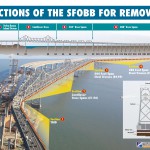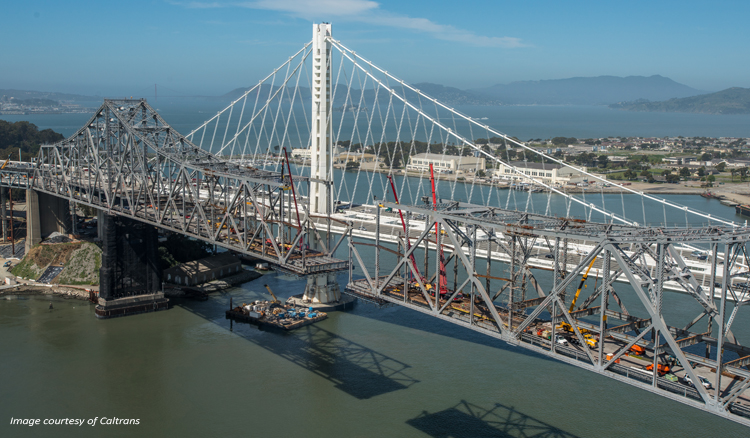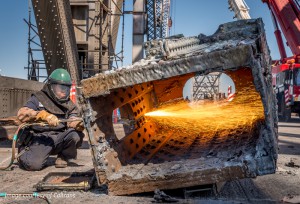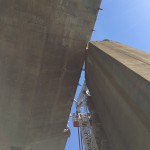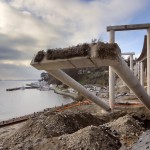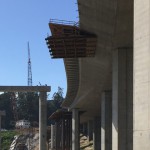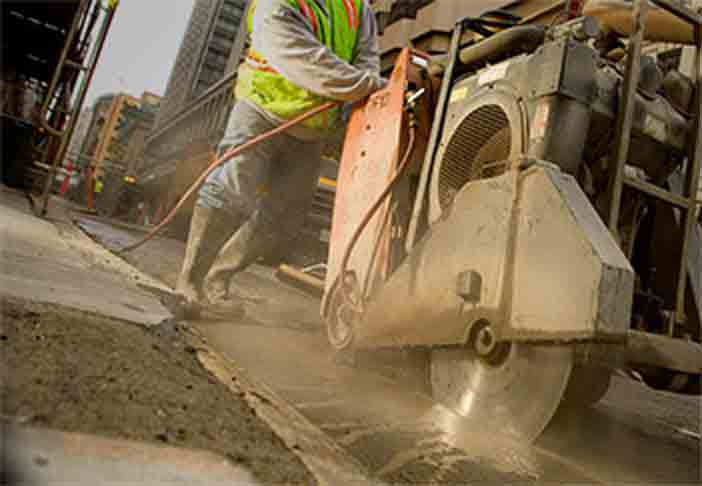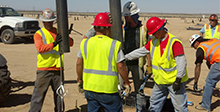Removing History
California Engineering Contractors / Silverado Contractors Dismantle the Bay Bridge
Beginning in 1936 cars and trains were able to go between San Francisco and Oakland as they never had before. That year, the San Francisco – Oakland Bay Bridge was put into service after many years of planning and three years of construction. An incredible engineering feat, the Bay Bridge was the largest and most expensive bridge of its time.
Stretching more than 5.5 miles, the Bay Bridge is actually two separate spans connected by a tunnel at Yerba Buena Island. In its inaugural year the Bay Bridge carried 9 million cars, far exceeding expectations. During its first 25 years of service, the bridge also carried trains on its lower deck. When taken out of service in 2013, the bridge carried 250,000 to 280,000 vehicles per day or about 100 million per year.
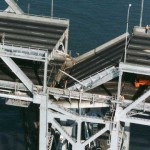
The upper deck at pier E9 on the Bay Bridge failed and crashed into the lower deck during the 1989 Loma Prieta earthquake.
After more than 75 years of service and the stress of heavy traffic loads, the 1989 Loma Prieta earthquake is what ultimately led to the demise of the Bay Bridge. The bridge was built to withstand vehicle loads and wind shear but not seismic shaking. The 7.1 magnitude earthquake caused a 250-ton section of the upper deck to collapse on the lower deck.
Once the bridge was repaired, an exhaustive analysis concluded that the bridge may not survive the next massive quake because much of the original eastern span was founded upon wood pilings driven through the soft mud in the east bay. Officials decided it was in the public’s best interest to completely replace the entire eastern span of the Bay Bridge and seismically retrofit the western span.
The eastern structure span is being removed through three separate contracts. The first demolition contract involves the removal of a nearly half-mile long cantilever truss section and a quarter-mile long transition section that connected the bridge to the Yerba Buena tunnel. In October 2012, the bids were unsealed, a joint venture between California Engineering Contractors (CEC) and Silverado Contractors was listed as the low bidder.
It wasn’t until January 2013 that CEC/Silverado was finally awarded the project. Even though the bridge was still in service when the project was awarded, the CEC/Silverado team worked with CalTrans to prepare the structure for demolition.
The plans called for the bridge to be dismantled in the reverse order that it was built. That meant cutting the suspension span that joined the two cantilever sections. But before the demolition team could separate the trusses, preparations had to be made to reduce structural tension on the bridge.
As soon as the bridge was taken out of service in September 2013, crews started to remove the concrete and steel from the top deck (westbound) of the suspended span as well as the bottom deck (eastbound). The structure was then jacked to pull each end of the suspended span toward the rest of the bridge.
After more than six months of preparations, in April 2014, the bridge was separated into two halves. At that moment the nearest support pier was 700 feet. Without these precautions, the two halves would have fallen into the water below.
Although it took more than 8,000 workers to build the bridge, it is being taken down by a few four-person teams. In total, the CEC/Silverado Joint Venture is carrying about 30 workers – 20 laborers and 10 operating engineers. At the peak the joint venture employed about 70 in the field.
Once the suspension span was separated, demolition teams started working in opposite directions, one east toward Oakland, and the other heading west. At each end of the span, crews of two laborers and two operators are literally cutting the bridge apart.
The laborers are suspended in a man lift basket, 200 feet above the San Francisco Bay by a crane operator. Another crane is rigged to the steel to be cut. The laborers, wearing protective coveralls and hoods, use torches to cut away a section of steel from the bridge. Once removed, the steel is lifted to the remaining bridge deck where it is cut into smaller pieces by additional laborers. The steel is then loaded into trucks by operators.
As with most older structures, care was taken to provide proper protection to all the works during the torch cutting. Stringent safety precautions were put in place. Sean Holifield, Operations Manager for Silverado states, “The hands have been outstanding. Not only are they trained up in the skills necessary to perform the work, they have made safety a paramount part of their daily activities. When safety is taken as seriously as it has been on this job, it makes everything else on a project run smoothly as well.”
Removing one member from a truss bridge can change the forces on the remaining members of the bridge, creating a potentially dangerous situation. To decide the best way to remove high-tension pieces, engineers are using a computer modeling program to determine how forces are distributed. As each steel member is removed, the engineers monitor a system of retroreflector prism targets to see if the forces are redistributed as predicted. No work proceeds until structural forces are evaluated.
In all, the cantilever truss section, spanning about 2,400 feet (less than a half- mile), requires the removal of more than 20,000 tons of steel and 12,000 tons of concrete.
While two teams worked to dismantle the suspended bridge and cantilevers, a third started to demolish the ‘S’ curve. The ‘S’ curve was a quarter-mile transition detour to the Yerba Buena tunnel built during the construction of the new Bay Bridge. 42 inch diameter false work that was originally used to build the new Bay Bridge was used to support the ‘S’ curve during its removal.
The ‘S’ curve presented a unique challenge as compared to the rest of the demolition – working in close proximity to the new bridge and live traffic. In fact, space between the new bridge and one of the old structural piers came within inches.
Once the bridge deck for the ‘S’ curve was removed it was time to take down the structural concrete support columns. The first of these columns (up to 140 feet tall) were taken down just like a tree. The remaining columns are being removed with the use of high reach excavators.
To fell the columns, concrete was chipped away from the bottom of the columns and the nine-foot rebar cage was cut at one side. Cables were then attached to the columns. At the other end, excavators pulled at the cables until the columns toppled over, exactly as planned.
One unique issue that has challenged the schedule of this project, as well as CEC/Silverado and Caltrans, is the Double-crested Cormorant. This migratory bird nests underneath the old bay bridge from April to August of each year. Once the Cormorants start laying their eggs permits to move the nests are difficult to come by because the bird is protected by the federal Migratory Bird Treaty Act and the California Fish and Game. Utilizing a snooper truck, CEC/Silverado is taking extra precautions to inspect for Cormorant nests and relocate them as permitted.
While this project was predominantly a demolition job, the final piece of the new San Francisco – Oakland Bay Bridge couldn’t be built until the ‘S’ curve was taken down. This final piece is a 2.2 mile pedestrian and bike path attached to the south side of the span.
Since the old bridge’s ‘S’ curve and the new bridge’s transition structure were so close to each other, there was no room to build the 15.5 foot wide path. As a result, CalTrans included the construction of the bike path in the demolition’s bid package.
But Silverado Contractors is in the business of removing structures, not building them. To aid in the building of the bike path, several subcontractors have been enlisted. The subcontractors include MCM Construction (structural concrete), OC Jones (paving and grading), Condon-Johnson (tiebacks & soldier piles), Bleyco (electrical), Frank Medina General Engineering (fencing and guardrails), and Stoloski and Gonzalez, Inc., (underground).
For more than a year, CEC/Silverado has been working on this first phase which is scheduled to wrap up in August. However two more sections of the bridge need to be dismantled before this iconic, but obsolete structure is removed from the San Francisco Bay.
The second phase, known as the 504/288 superstructure, was bid in March 2015. The CEC/Silverado team was awarded the second project which will allow the demolition of the bridge to continue seamlessly.
“Knowing that a good union contractor, like CEC/Silverado, has been awarded the first two phases of the bay bridge demo is fantastic,” says Laborers’ Local 304 Business Manager Fernando Estrada. “Although both projects don’t involve a lot of man-power, the laborers involved in it will be part of history. Projects like this are a reminder that in order to make progress sometimes we may need to remove a piece of history along the way.”






